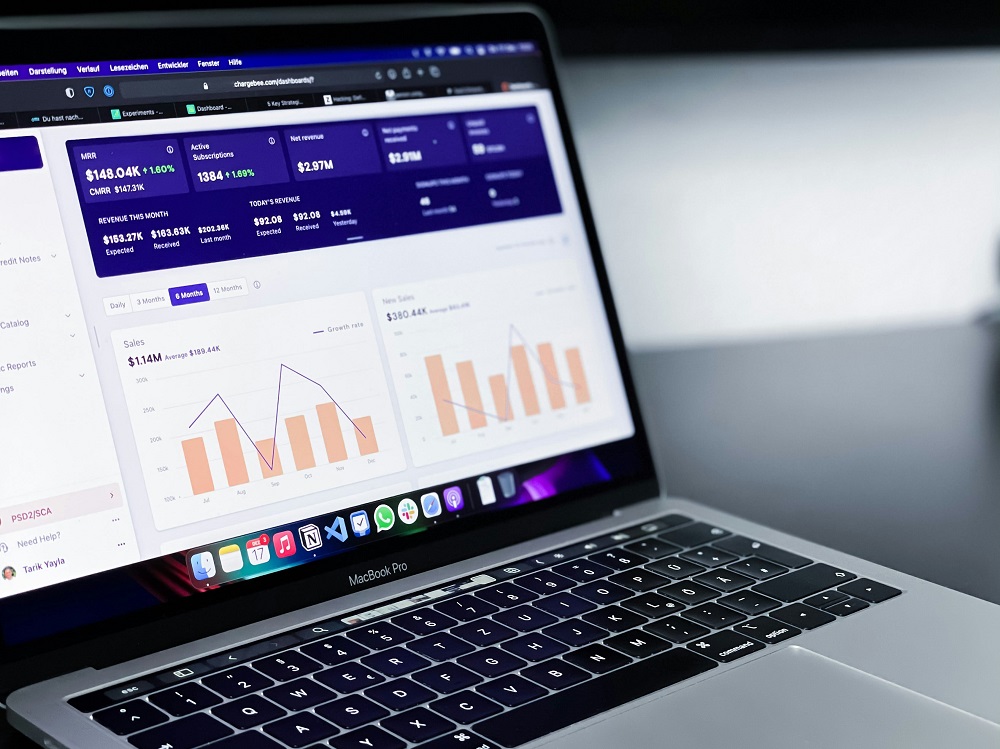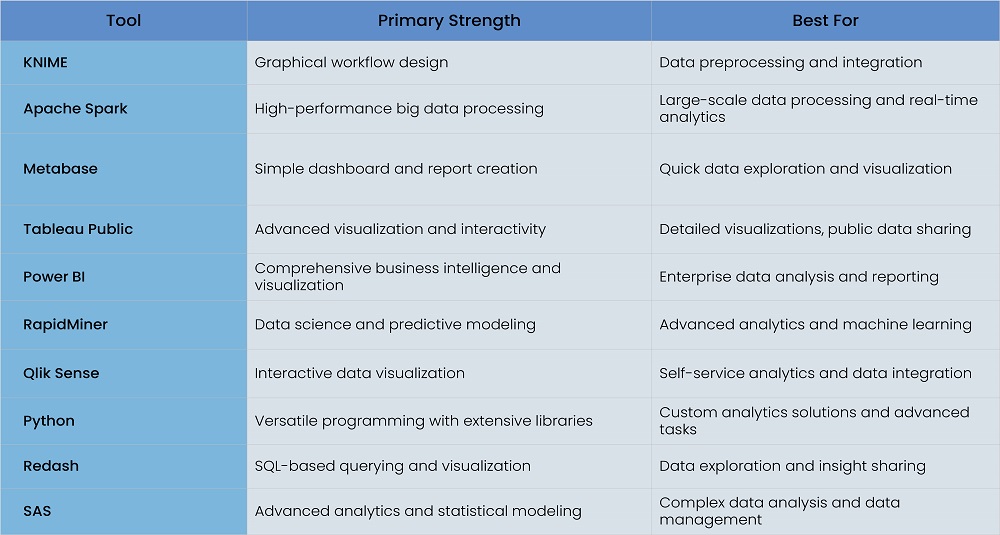With the field of data analytics constantly evolving, organizations are embracing open-source tools due to their flexibility, lower pricing, and solid features. Open-source applications, including data analysis and visualization tools, are useful for organizations that want to use their data efficiently. This article focuses on the best open-source data analytics tools, their comparison, and tools that will suit organizational requirements best.
Best Open Source Data Analytics Tools
KNIME
KNIME is a growing open-source data mining tool that is well known for its ability to design data workflows. It has a simple drag-and-drop approach to complex data processing and more capabilities than common programming tools, even for nonspecialists who only want to code a little. This highly organized and decomposed structure makes it easier for users to handle a variety of processing and analysis functions on the software quickly and effectively. This makes it more efficient to combine and analyze data from different places and even perform intricate analyses.
Benefits
- Diverse Functionalities: The tool provides a unique and seamless platform for carrying out a complete range of data analysis activities, from desktop reporting to data mining and machine learning applications.
- Affordability: Since it is a freely available tool, organizations do not incur any costs for using it, thus making it a helpful alternative for institutions that intend to cut down on costs.
Apache Spark
Apache Spark is the latest high-performance and highly available open-source data processing system oriented towards large amounts of data analysis. These open-source analytics tools for big data are resource-efficient. In contrast to disk-based systems, Spark does not offer a batch-oriented approach but instead interacts with the data in the RAM in a time-efficient manner.
Benefits
- Speed and Efficiency: It’s necessary to note that, taking into account that Spark is capable of utilizing in-memory processing on the other hand, it implies that the data analysis is likely to be performed in real-time, which cuts down drastically on time wasted on processing.
- Scalability: This is meant for working with large amounts of data; therefore, Spark's architecture is built to scale in large clusters and run big data applications.
- Versatility: In a single framework, batch processing, real-time processing, machine learning, and graph processing can all take place; hence, it is versatile.
Power BI
Power BI is Microsoft's business intelligence, designed to offer information visualization and analysis tools to acquire great results. Even though Power BI is a closed-source product, it works well with other open-source products, and it can import data from various sources ranging from SQL databases and Excel sheets to online cloud services.
Benefits
- Advanced Visualization: The performance of Reports with Power BI helps users employ the varied visualization available and customize these reports. Leveraging Power BI consulting can enhance data visualization and reporting, turning raw data into actionable business intelligence.
- Seamless Integration: Rapid sharing and cooperation are due to the incorporation of Microsoft products and services.
- Scalable Solutions: The deployment of Power BI is also flexible and can expand from small working groups to larger organizations.
Read more: List of Top 10 Best Data Visualization Tools: Guide
RapidMiner
RapidMiner is an open-source data science software that comes with many features for data prep, model building, and programmatic validation of predictive models. It is designed so that its users can easily work on data flows and create models without having to learn programming. It works on many forms of data analysis, such as data mining statistical analysis, and there is a machine learning engine.
Benefits
- Reusable Content and Canned Responses: Alternatively, there is an opportunity to employ the work by releasing reusable components with 3-click operations on a web browser.
- Visual Collaboration Tools: Including a wide range of data workflow management tools has made it very easy for users as some requirements and resources change over time.
Metabase
Metabase connects to several data sources, such as SQL databases, Google Analytics, and data warehouses. It has native drivers for known database engines such as MySql, PostgreSQL, and MsSQL, which enhance data connection. It has a drag-and-drop Query Builder, enabling users to build queries instead of SQL to perform complex queries.
Also, one of the most praised features of Metabase is the ability to create interactive and exportable dashboards based on the created analyses. The users can create custom graphics such as graphs, pie charts, and data tables to embed into documents or share with other colleagues.
Benefits
- Customizable Dashboards: The advantage of being able to create and share interactive dashboards is that information can be easily illustrated and relayed.
- Cost-Effective: The best thing about Metabase is that it is an open-source tool, which means no payment is required, which is a good option for BI software.
- Data Integration: It provides integration and analysis capabilities by enhancing its user interface with numerous data sources and embedded connectors.

Tableau Public
Operating in the same sense is the Tableau Public database, where users of an open-source data visualization resolution can come along and upload wetter posters. Today, Tableau Public is a website that allows users to share and use visual data online freely. With it, share comments that can explain more about Tableau Public.
Tableau has a wide range of visualization options. These visuals can be modified when necessary depending on how best one wants the presentation to be made. The application also allows the users to blend and aggregate the data from different sources and conduct various analyses.
Benefits
- Interactive Visualizations: Effective ways of providing reports, such as using Tableau Public, have their illustrations made appealing and serve the purpose rather well, owing to the many possibilities of dynamic report creation and editing.
- Online Sharing: The features of publishing visualizations on the web and granting a view to the public dominantly increase data accessibility and the interaction of the audience.
- Community Resources: There is also a wide range of shared visualizations available on Tableau Public among the community members that allows for education as well as creativity.
Qlik Sense
Qlik Sense is famous for its associative data model, whereby QlikSense users are able to query and analyze data from different systems every day without using any filters or pre-defined poles.
The interface is simple and interactive with good drop and drag support, so complex users do not have to be deep in the technical know-how. Without needing external assistance, Ackemia is sufficient to tackle complicated statistical processes or analyze business processes by combining different statistics. This platform is rich in variations, including but not limited to bar charts, line charts, heat charts, and any other important chart needed for analytical purposes.
Benefits
- Associative Data Model: Qlik Sense’s associative data model is a unique feature that facilitates users' analysis of data in various ways in order to find new information hidden within the data.
- Intuitive Interface: The creation of visually appealing bison and dashboards is made more accessible with the adoption of a point-and-click, drag-and-drop method, which is user-friendly to individuals with different technical skills.
- Self-Service Analytics: Giving users the authority to generate their reports and dashboards lessens their reliance on IT and, therefore, enhances faster decisions.
- Comprehensive Data Integration: The ability to pull data from multiple sources is a real-time organizer because it helps trim down the time required to analyze data.
Read more: Top Data Engineering Tools
Python
An open-source programming language, Python assists developers with databases, including advanced text features such as data analytics and data science. The Python environment contains a large number of libraries and frameworks specially developed for data processing, analysis, and visualization.
It also allows users to integrate with different tools and platforms and, therefore, build complete data processes. The growth of the language in the data science field implies that there is plenty of information, guides, and forums available for the users.
Benefits
- Flexibility: The various libraries and frameworks of different types in Python are helpful in all stages of the data analysis process, from the data preparation stage to the data visualization stage.
- Integration Capabilities: The ability of Python to integrate with other tools and platforms enhances its utility in building comprehensive data workflows.
- Community Support: Resources such as tutorials, forums, and third-party packages are provided thanks to Python's well-rounded and active community forums.
Redash
Redash is an open-source tool where the user can perform queries as well as visualize data from some sources. The interface allows the user to input SQL statements and manages the output to visualize the statement, and thus, insights can be shared amongst the team. Redash supports an extensive database of data sources, including SQL, NoSQL, and web APIs.
Redash’s query editor is one of its key components, and it supports not only SQL queries but also other types of queries. Users can create customized queries to retrieve queries from remote sources and display the data applications via available charts and graphs. Usages like the design of dashboards and their dissemination to concerned audiences are also facilitated, wherein data concerns are efficiently expressed.
Benefits
- Custom Queries: The flexible nature of Redash allows users to write and execute their SQL statements using the Redash query editor to extract data in any way necessary.
- Dashboards and Sharing: Users can create and share dashboards, which allows them to share insights and work together.
- Alerting System: Users can define alerts based on even the query results, thus controlling a few metrics and taking timely actions to the changes in the data.

SAS
SAS Statistical Analysis System is a full-featured and robust open-source application that is used for advanced analytics, business intelligence applications, and even data management. While SAS provides different types of systems, such as proprietorship and open-source components, the open-source types of SAS have potent abilities in data processing and statistical modeling.
SAS has many tools for data processing, statistical research, and predictive modeling. With plenty of different functions in the library of the software and procedures, data cleanup, changing, and other kinds of actions are simple and possible. Users can efficiently conduct a number of statistical analyses, develop numerous predictive analytics, and prepare numerous reports with the help of SAS.
Benefits
- Comprehensive Analytics: SAS is equipped with a number of applications for acquiring, processing, and modeling data.
- Robust Functionality: Due to the rich library of functions and procedures, users are able to carry out intricate analytical and modeling techniques over data.
Benefits of Using Open-Source Data Analytics Tools
The open source data analytics tools are gaining importance as they come with certain advantages. Let us now analyze a few significant advantages of these tools:
-
Cost Advantage
These tools are quite often open-source solutions that do not require the purchase of high-cost software licensing or subscription. Licensing fees have become a huge burden. Hence, by getting rid of them, companies keep their finances for other important needs like data modernization, infrastructure, employee skills, and advanced analysis.
-
Flexibility and Modifications Possibilities of an Open Source Tool
There is a high level of flexibility and modifications of open-source tools compared to commercial packages. With proprietary software, there are usually preset capabilities and constraints, while open source allows the editing of the source code. Integrating these tools with big data analytics consulting can provide deeper insights and more robust analytics.
-
Transparency and Control
The information systems can be examined for their purpose since the source code is readily available, and users can access them usually with any password. This transparency in information is vital because it enhances the security and integrity of the relative data.
-
Community Support and Collaboration
These tools have stakeholders like developers, end-users, or contributors to the software, and every one of them seeks to enhance the software, respond to user questions, and educate others.
Read more: Top Data Governance Tools
Comparison of Popular Open-Source Data Analytics Tools
Here’s a comparison of the ten popular open-source data analytics tools:

How to Choose the Right Open-Source Data Analytics Tools?
Choosing the right open-source tool for data analytics services tool is very important. Here are some points that need to be considered:
-
Define Your Requirements
List the data and analysis that you need. Get the answer to the question of whether the reporting is set to be simple or even more advanced.
-
Check Key Features Common to Different Tools
Look at whether a particular tool is able to connect to the database or source, whether there are capabilities to visualize the data appropriately, and whether the tool can store such a massive amount of data.
-
Scalability and Performance
It should provide further scope to accommodate future needs pertaining to the data requirements and also work smoothly and efficiently under the workload you have.
Read more: Top 10 Data Modeling Tools You Need To Know
Summary - Open Source Analytics Tools
There are many open-source data analytics platforms available that include lots of valuable components for the administration and interpretation of the data. Every tool has its niche, from the easy-to-use workflow of KNIME to the highly advanced speed of Apache Spark. These data analytics tools can be selected depending on their functionality, ease of use, integration, community support, price, and any other feature.
A leading enterprise in Data Analytics, SG Analytics focuses on leveraging data management solutions, predictive analytics, and data science to help businesses across industries discover new insights and craft tailored growth strategies. Contact us today to make critical data-driven decisions, prompting accelerated business expansion and breakthrough performance.
About SG Analytics
SG Analytics (SGA) is an industry-leading global data solutions firm providing data-centric research and contextual analytics services to its clients, including Fortune 500 companies, across BFSI, Technology, Media & Entertainment, and Healthcare sectors. Established in 2007, SG Analytics is a Great Place to Work® (GPTW) certified company with a team of over 1200 employees and a presence across the U.S.A., the UK, Switzerland, Poland, and India.
Apart from being recognized by reputed firms such as Gartner, Everest Group, and ISG, SGA has been featured in the elite Deloitte Technology Fast 50 India 2023 and APAC 2024 High Growth Companies by the Financial Times & Statista.









